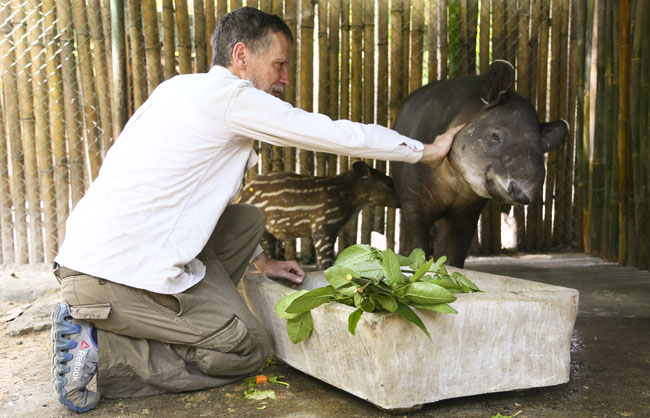Tapir,Tapirus bairdii, can be studied at AutoSafari Chapin, Guatemala
We have been doing research on mammals, birds, reptiles, and other animals of the Mayan areas of Mesoamerica for several years at the open-air zoo AutoSafari Chapin. This August we spent two days here (en route to Monterrico, Pacific Ocean, to study water birds there).
Since I have never seen a tapir in the wild in Guatemala, I wish to learn more about tapirs by studying them at AutoSafari Chapin. Several months ago Francois Berger kindly took me “backstage” to where the mothers who had babies were kept. He showed me that the mothers and the young tapirs were used to having people in their living area. So today I returned, to see whether I could have the tapir mother and baby interact with me.
The baby tapir was more or less curious, but not like a cat or dog whatsoever. It enjoyed attention but was quite independent. So I decided to see if I could interact with the mother.
When I noticed that the mother tapir was closing her eyes in peaceful relaxation, I realized quickly that the mother tapir loves being rubbed just behind its jowls. She got so relaxed that I sensed she was getting ready to lay down to get rubbed even more. The baby tapir likes it also but was too active to receive full massage.
Pancho the peccary however, got literally so relaxed he lay down on the ground with his feet in the air, just like a dog. Pancho was totally happy with me, as was the tapir. However two days later, when we were with the 6 month old jaguar cub, I quickly learned that his personality was very different than that of a peccary or tapir.
Dr. Nicholas Hellmuth petting a Tapir, Tapirus Bairdii, at the AutoSafari Chapin
Tapir habitat is endangered
Dams for hydroelectric projects are one potential cause of habitat destruction. Strip mining is equally damaging to the eco-systems of Guatemala. Another major cause of destruction is bulldozing vast areas for planting Brazilian rubber trees, or teak.
Even more destructive is African oil palm plantations, since the noxious chemicals used in this industry cause near total destruction of all creatures in the river: the fish die first, then the water birds that feed on the fish; then the crocodiles and caimans.
A few tapir are killed for their meat, but I estimate a major headache for herds of tapir is the above mentioned destruction of their habitat.
Our long-term interest is the work to encourage the development of protected eco-systems where native plants and animals have a better chance for survival.
Public education is a helpful first step. So we are ourselves working to understand the different animals, to understand them as personalities. Each species has a different personality (though both the peccary and the tapir really like direct personal interaction as a form of communication).
After this initial interaction with both the mother tapir and her young, I definitely have a closer feeling for these animals. It is so much more encouragement to have a close encounter with the animals you seek to protect.
Posted late August 2015
after our umpteenth educational research visit to AutoSafari Chapin, en route to Canal de Chiquimulilla, Monterrico, Guatemala.
























